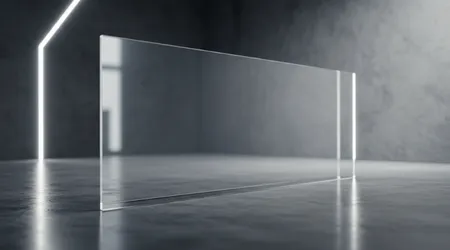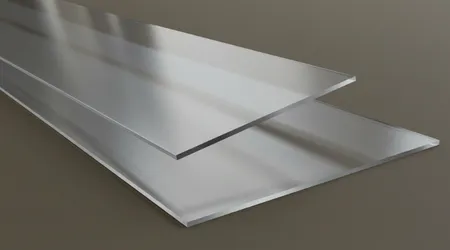Transparent Aluminum: Sci-Fi Material Turned Real

Transparent aluminum, a material once confined to the imaginative realms of Star Trek, has transcended fiction to become a groundbreaking reality in 2025.
Anúncios
This remarkable substance, scientifically known as aluminum oxynitride (ALON), blends the strength of metal with the clarity of glass, offering a glimpse into the future of materials science.
Its journey from a Hollywood script to cutting-edge applications in aerospace, defense, and optics is nothing short of extraordinary.
But what makes this material so revolutionary, and why should we care about its emergence?
This article dives deep into the science, history, and transformative potential of transparent aluminum, exploring its properties, production breakthroughs, and real-world impact.
Anúncios
The allure of transparent aluminum lies in its paradoxical nature: a metal that you can see through, yet tougher than most traditional materials.
First popularized in Star Trek IV: The Voyage Home, where Scotty trades its formula for a tank of whales, the concept captured imaginations worldwide.
Today, it’s no longer a plot device but a tangible innovation driving advancements across industries. From bulletproof windows to smartphone screens, its applications are as diverse as they are impactful.
Let’s unravel the story of how transparent aluminum evolved from a sci-fi fantasy into a cornerstone of modern engineering, and why it’s poised to reshape our technological landscape.
The Science Behind Transparent Aluminum
At its core, transparent aluminum is aluminum oxynitride, a polycrystalline ceramic composed of aluminum, oxygen, and nitrogen.
Its cubic spinel structure allows light to pass through while maintaining exceptional hardness. Imagine a window that’s as clear as glass but can stop a .50 BMG round ALON achieves this.
According to a 2005 U.S. Air Force study, 1.6-inch-thick ALON armor can halt armor-piercing rounds that penetrate 3.7 inches of conventional glass laminate. This durability stems from its tightly packed molecular structure, which resists fracturing under extreme stress.
ALON’s optical clarity spans near-ultraviolet to mid-infrared wavelengths, making it ideal for advanced optics. Unlike glass, it’s four times harder than fused silica and nearly as tough as sapphire.
Its lightweight nature less than half the weight of traditional bulletproof glass enhances its appeal for mobile applications.
Picture a fighter jet’s canopy: ALON provides unobstructed views while withstanding high-speed impacts. This balance of transparency and resilience is what sets transparent aluminum apart from its predecessors.
++ The Hunt for the Fifth Force of Nature
The material’s chemical stability also makes it resistant to oxidation and radiation, perfect for harsh environments like space or nuclear facilities.
Its versatility allows fabrication into windows, domes, or rods using conventional ceramic techniques. However, its complex composition aluminum content varying from 30% to 36% requires precise engineering to maintain consistency.
Recent advancements in sintering and polishing have further boosted its mechanical strength, opening new possibilities for its use in everyday technology.

A Brief History: From Fiction to Reality
The concept of transparent aluminum first dazzled audiences in 1986, when Star Trek depicted it as a futuristic marvel. Yet, the seeds of its reality were sown decades earlier.
In the 1980s, scientists at Surmet Corporation began developing ALON, patenting methods to create transparent ceramics.
By 2005, the U.S. Air Force was testing ALON-based armor, proving its real-world viability. This transition from fiction to fact mirrors how sci-fi often inspires scientific breakthroughs, much like H.G. Wells’ predictions of lasers and nuclear technology.
Also read: How Magnetic Fields Might Influence Human Behavior
Early production of ALON was costly, requiring high-pressure sintering and specialized equipment.
The 2009 breakthrough at Hamburg’s FLASH laser facility marked a turning point, rendering aluminum temporarily transparent using X-ray pulses.
While this experiment lasted only 40 femtoseconds, it validated the material’s potential.
Fast-forward to 2025, and researchers at Ateneo de Manila University have simplified production using droplet-scale anodization, a low-voltage technique that transforms aluminum into a transparent oxide layer with minimal resources.
This evolution reflects a broader trend: science fiction doesn’t just predict the future it challenges scientists to make it happen.
Today’s ALON is a testament to human ingenuity, turning a once-impossible idea into a practical solution.
Its development underscores the power of interdisciplinary collaboration, blending physics, chemistry, and engineering to push material science forward.
Breaking Down Barriers: Production Innovations
Producing transparent aluminum has historically been a hurdle due to its high costs and complex processes. Traditional methods involved high-powered lasers, vacuum chambers, and hazardous acids, limiting scalability.
However, 2025 has brought game-changing innovations. The droplet-scale anodization technique, pioneered by Ateneo de Manila University, uses just 2 volts and a microdroplet of acid to create a transparent oxide layer.
This eco-friendly approach reduces energy consumption and environmental impact, making ALON more accessible.
The process relies on electrowetting, where an electric current manipulates acid droplets to form a uniform, nanoporous aluminum oxide layer.
Read more: Quantum Biology: How Birds May Use Quantum Mechanics to Navigate
This layer, analyzed via X-ray photoelectron spectroscopy, stabilizes into an amorphous, transparent film. Unlike traditional anodization, which yields opaque results, this method achieves clarity with minimal resources.
It’s like sculpting a statue with a fine chisel instead of a sledgehammer precision yields better results.
These advancements are lowering costs, making ALON viable for consumer applications like smartphone screens or architectural windows.
Yet, skeptics argue that localized anodization isn’t entirely novel, as similar techniques have been explored before.
The real test lies in scaling this process for industrial use without sacrificing quality, a challenge researchers are tackling with gusto.
Real-World Applications: Where Transparent Aluminum Shines
The versatility of transparent aluminum is reshaping industries. In defense, ALON’s ability to stop high-caliber rounds makes it ideal for lightweight, transparent armor.
For example, a military vehicle equipped with ALON windows can maintain visibility while protecting occupants from ballistic threats.
This is a game-changer for troop safety, reducing the weight of armored vehicles without compromising security.
In aerospace, ALON’s impact resistance and clarity are perfect for cockpit canopies and satellite optics. Consider a satellite orbiting Earth: its sensors, shielded by ALON, can capture clear images while enduring cosmic radiation.
The material’s lightweight properties also reduce fuel costs, a critical factor in space missions. By 2025, companies like Surmet are scaling production for aerospace clients, signaling broader adoption.
Beyond defense and aerospace, ALON is making waves in consumer electronics. Imagine a smartphone with a screen that’s virtually unbreakable yet crystal-clear ALON could make this a reality.
Its use in optical sensors and laser systems is also growing, driven by its ability to transmit light across a wide spectrum. The table below summarizes ALON’s key applications and benefits:
| Industry | Application | Benefit |
|---|---|---|
| Defense | Bulletproof windows | Lightweight, stops .50 BMG rounds |
| Aerospace | Cockpit canopies, sensors | Impact resistance, optical clarity |
| Electronics | Smartphone screens | Durability, scratch resistance |
| Optics | Laser systems, IR windows | Broad-spectrum transparency |
Challenges and Future Prospects
Despite its promise, transparent aluminum faces challenges. High production costs remain a barrier, though innovations like droplet-scale anodization are closing the gap.
Scaling these methods for mass production without compromising quality is the next hurdle. For instance, creating large ALON panels for architectural use requires uniform clarity, which current techniques struggle to achieve consistently.
Environmental concerns also loom. Traditional ALON production is energy-intensive, contributing to carbon emissions. While newer methods are greener, their long-term sustainability needs scrutiny.
Researchers are exploring recyclable ceramic composites and energy-efficient sintering to address this. Could transparent aluminum become as ubiquitous as glass, or will it remain a niche material for high-stakes applications?
Looking ahead, the future is bright. By 2030, analysts predict ALON could capture a significant share of the transparent armor market, valued at $1.2 billion in 2024.
Advancements in additive manufacturing and automation are poised to make ALON more cost-effective, potentially revolutionizing industries from construction to medical devices.
The material’s ability to inspire innovation is akin to a spark igniting a wildfire its potential is vast and untapped.
The Cultural Impact of Transparent Aluminum

The journey of transparent aluminum from Star Trek to reality highlights the symbiotic relationship between science fiction and science. Sci-fi doesn’t just entertain; it plants seeds of possibility.
When Scotty bartered the formula for transparent aluminum in 1986, it sparked curiosity among scientists, much like Jules Verne’s submarine inspired naval engineering. This interplay underscores the power of storytelling to drive innovation.
Beyond science, ALON’s emergence challenges our perception of materials. A transparent metal defies intuition, forcing us to rethink what’s possible.
For example, an architect designing a skyscraper with ALON windows could create structures that blend strength with aesthetic brilliance. This material invites us to dream bigger, pushing the boundaries of engineering and design.
Public fascination with transparent aluminum also fuels its adoption. Social media platforms like X buzz with discussions about its applications, from sci-fi fans celebrating its Star Trek roots to engineers debating its scalability.
This cultural resonance ensures ALON remains a topic of interest, driving investment and research into its potential.
Conclusion: A Window to the Future
Transparent aluminum is more than a material it’s a testament to human creativity and perseverance. From its sci-fi origins to its real-world applications, ALON embodies the leap from imagination to innovation.
Its ability to combine strength, clarity, and versatility positions it as a cornerstone of future technologies. Whether shielding soldiers, enhancing spacecraft, or protecting your next smartphone, transparent aluminum is rewriting the rules of materials science.
As we stand in 2025, the question isn’t whether transparent aluminum will shape the future, but how far its influence will reach.
Will it become as commonplace as glass, or remain a specialized marvel? Only time will tell, but one thing is clear: this once-fictional material is now a reality, opening windows literally and figuratively to a world of possibilities.
Let’s keep pushing the boundaries of what’s possible, inspired by the dreams of yesterday and the innovations of today.
Frequently Asked Questions
Q: What is transparent aluminum made of?
A: Transparent aluminum, or ALON, is a ceramic composed of aluminum, oxygen, and nitrogen, forming a cubic spinel structure with exceptional clarity and strength.
Q: Is transparent aluminum used in consumer products?
A: While primarily used in defense and aerospace, ALON is being explored for consumer electronics, like durable smartphone screens, with production costs decreasing.
Q: How does transparent aluminum compare to glass?
A: ALON is four times harder than fused silica glass, lighter than traditional bulletproof glass, and resistant to extreme conditions, making it superior for high-performance applications.
Q: Can transparent aluminum be mass-produced?
A: Recent innovations, like droplet-scale anodization, are making mass production more feasible, but challenges in scaling large, uniform panels persist.
Q: Why is transparent aluminum so expensive?
A: High energy costs and complex processes like sintering drive up expenses, though new techniques are reducing costs for broader applications.
